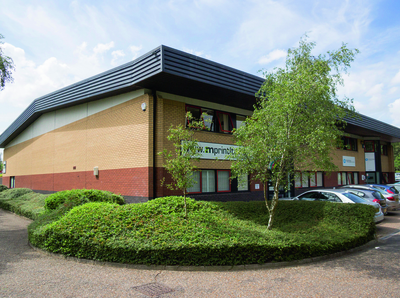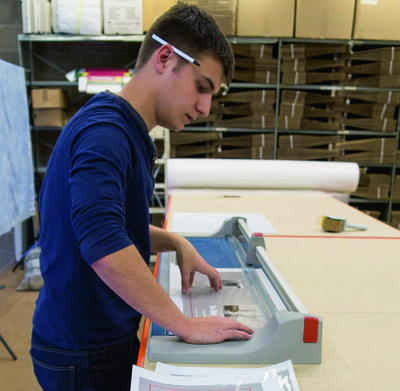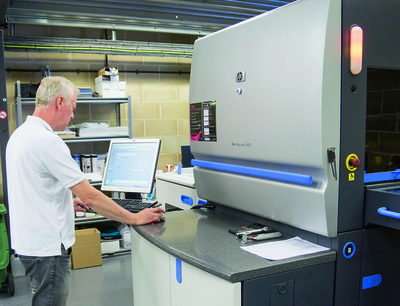Ian Tribe printed the book job on the HP Indigo 5500
How does a photobook service work in practise for a relatively small printing company? Simon Eccles created a book and followed it through the complete production cycle at 2M Printing in Norwich.
Big photolabs and retail chains may seem to have the market for photobooks sewn up, but fortunately there’s still room for an agile-minded independent printing company to trade successfully in this sector. 2M Printing in Norwich is one such business, employing just 11 people and offering both B2C and numerous B2B and professional services, taking in some large (but anonymous) organisations that hardly count as niche.
We decided to follow the progress of a real book through its system, looking at the reason for the choice of production kit and methods at each stage.
2M’s customers include corporates, publishers, property companies and professional photographers as well as domestic consumers. Not all the work is photo books, with other services on offer such as canvas prints and greetings cards. Schools are a significant growth area.
The company was set up in 2007 Mike Hipperson and his son Mark (the 2Ms of the name) and was all-digital from the start, installing an HP Indigo 5500. Taopix was chosen for the online photo products creation and workflow software, via its distributor Transeomedia.
‘In the early days of photobooks we spent time trying to develop our own software, but we were always one step behind,’ says Mike Hipperson. ‘We got together with Transeomedia and Taopix. It’s been a great working partnership. They have very good technical people. We now have some very experienced people ourselves and do Betas with Transeomedia now. We are their largest growth customer.’
The Taopix system allows for ‘white label’ branding, which might be the printer’s own brand, or branded as a service for customers, for example a school or sports club. ‘This requires a skill base, especially of graphic designers who know how to request the right imagery,’ said Mr Hipperson. ‘Our designer, Ashley Johnson, has really embraced the technology and manages the whole thing with his team. We can have constructive meetings with customers at different levels to understand their requirements. We’ve developed our sales abilities to get in at a very senior level and show them what’s in their interests and to get the budgets.’
Consumer focus
Domestic consumers are also major customers for the photobook and photoproducts. 2M’s consumer photoproducts service (also used by some companies) is called Smiley Hippo, a name inspired by the Hippersons’ surname.
Customers going to the website for the first time are offered a choice of ‘Quick Create’ or ‘Software download.’ These correspond to the two Taopix products, Online and Desktop.
Taopix Online is a relatively new Cloud based system where the customer uploads all images and then works within a web browser to turn them into photo products, then orders and pays for them.
The customer can start working right away on any platform, including tablets or even smartphones at a pinch. Although this means that all the photographs have to be uploaded to the website in their original resolutions, Taopix has developed an apparently unique ability to allow the customer to start working on rapidly uploaded thumbnails immediately, while the full res uploads in the background.
Desktop is the original Taopix system where the customer downloads a photoproducts creation program and a set of templates and other elements that runs on their own Mac or PC. All the processing is carried out locally and can be offline. Only the smaller optimised image files need to be uploaded when the order is placed. Desktop is too big to run as an app on a tablet. Download and installation is only needed once, though new templates, backgrounds, frames and so on are often added as additional downloads.

2M moved into its new site on the Norwich outskirts early this year
Customer end creation
With our book we took the Download route, largely because that was the only option when first copy of the book was created in 2011. Online was introduced at the end of 2012.
Setting up a complex book with multiple text columns was a lengthy business (also because some external graphics had to be created to fit as we went along), so it was useful to be able to save the project and return to it over a period of days. It’s possible to preview the finished appearance at any point on screen, but there’s no facility for local proof prints, even with watermarks.
Once completed, you click on the shopping basket logo, and the software runs a rapid check for missing image files and the like, then puts the project into a shopping basket ready for the order to be placed. 2M offers a standard delivery (up to nine working days) or Express (up to four days).
Behind the scenes, the Taopix desktop software exports the files as PDFs (though TIFF or JPEG might be used if the destination is a sliver halide lab), generates job instructions, then encrypts the files so they can only be opened by 2M itself, which has the relevant software decryption key.
At the receiving end the Taopix server decrypts the files and automatically handles most of the workflow up to placing the PDF files in job queues. 2M’s staff exercise some manual control though, largely to choose the finishing route depending on the job type.

Covers are printed on an Epson ikjet and laminated before being trimmed
At the receiving end
With the order placed, we followed our book to watch and photograph it being produced 2M’s factory site on the northern outskirts of Norwich, a couple of miles from the airport.
2M was originally set up in on a smaller site in 2008. Mike Hipperson had originally trained as a printer but sent most of his career in the paper supplies sector. Mike also went into printing and by 2000 he was a director at F Crowe & Son (known as Crowes). Mark joined him after an MBO at Crowes and they worked together for the next few years.
In 2007 they left and started to set up their own business, that became 2M. They installed an HP Indigo 5500 digital press and steadily expanded into first two and then three factory units.
‘We did personalised brochures for London financial houses, and then we moved into photobooks,’ said Mike. ‘In the past couple of years we’ve also moved into other book solutions. We developed an on-demand service to publishers, including one major client that needs multi-lingual versions in many titles. We set up W2P for them and they can order top-up stock on a daily basis. They can order ten copies per language – with offset it was a minimum of 300.’
By last year the Hippersons had decided to bring the operations under one roof, so started looking for the right premises. ‘It was hard to find the right sort of place that wasn’t too industrial, with an office suite,’ said Mark Hipperson. ‘Half of the people we employ are software and pre-press.’
They found a former NHS data warehouse with offices on two levels at the front, plus a large production space with a spacious mezzanine floor at the back. Usefully, there was already a small lift between the production floors, which is handy for moving heavy items. 2M moved to the site in January this year.
The original HP Indigo 5500 digital press has been joined by an MGI Meteor DP 8700XL, a sheet fed toner press that can take very long sheets up to 330 x 1,050 mm. This is particularly valuable for the increasingly popular layflat books, as it can handle A4 landscape spreads (which need at least a 660mm sheet) and even wider panorama formats.
Our book was A4 landscape and not layflat design, so the block was printed on the HP Indigo press by 2M’s operator Ian Tribe, Most covers, including the one on our book, are printed on a wide format Epson Stylus Pro 9890 and then laminated.
The need to produce books of variable format and thickness meant that a standard PUR binder couldn’t cope. The solution was a CP Bourg BB3002 binder with Nordson PUR gluing unit, ordered at drupa 2012. This is used for longer runs and particularly thick books, though one-offs like our book are handled by a small manual Maping Fastbind hotmelt unit.
Post-press binding and assembly of our book was handled by Tom King, whose main job is operating the Meteor press. ‘We encourage staff to move around and learn to operate everything,’ said Mike Hipperson.
Taopix automatically generates a job instruction sheet that travels around the factory with the book. Thumbnails of the pages help to ensure that the right cover goes on every book, and it is then dispatched to the correct address.
Hard covers for our book were made up on a Maping Fastbind Casematic system, supplied by Ashgate Automation. This is a manual assembly table with guides, a backlight and an edge folder. This allows the printed cover to be aligned and attached to pre-cut greyboards using peel-off adhesive, and then the sheet edges are neatly folded around the boards. Finally the book block was positioned in the cover and attached by more peel-off adhesive.
‘In coming weeks we’ll be investing in more equipment at the finishing end, to meet projected demand for layflat,’ said Mr Hipperson. ‘There’s considerable demand for this even in commercial environments.’
Currently 2M uses Fastbind FotoMount system to create layflat books. This is a semi-manual process and uses peel-off adhesive sheets to attach the sheets back-to back. The process is flexible and can create practically any shape or thickness of book, but it’s comparatively slow, plus the adhesive sheets are more expensive than a liquid glue. This is why 2M is interested in a mechanised layflat book gluer. Mr Hipperson said he’s visited all the main suppliers, but isn’t ready to announce his decision yet.
Imminent expansion
Indeed, business is increasing well enough that 2M is preparing to invest across the board, he said. In addition to the layflat investment, Mr Hipperson says that the company is planning on a more automated way of producing hard cases and casing them in. There will also be a third press on order within a couple of months. Again he won’t name names, but hints that it’s something significantly different. By the look of things there’s plenty for to keep that Hippo smiling.





